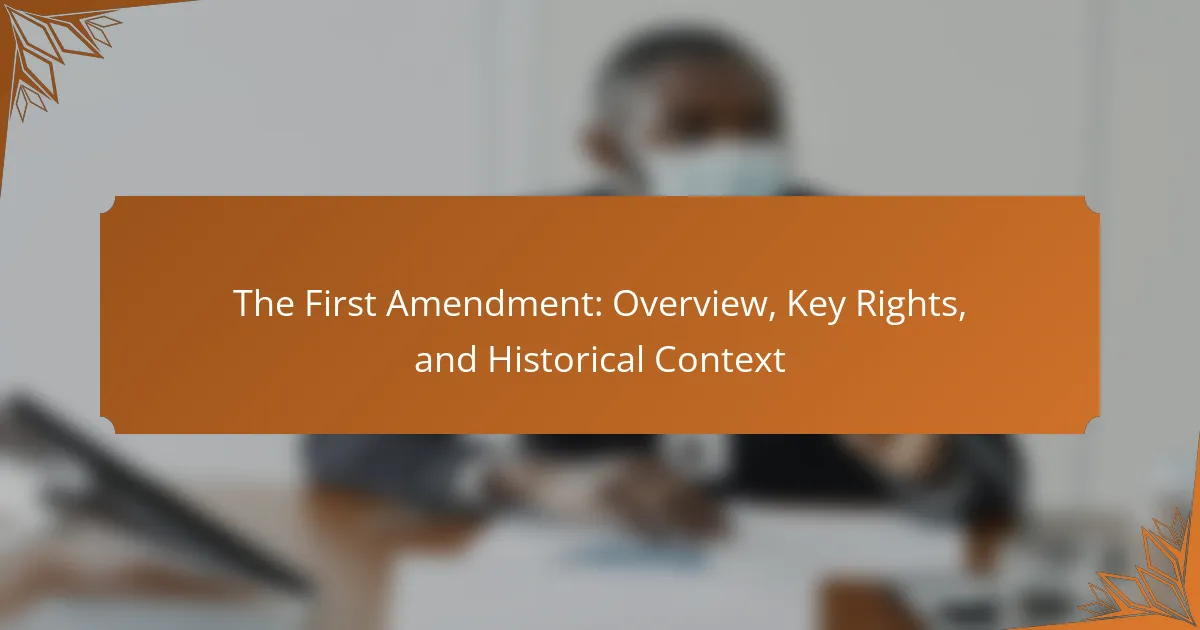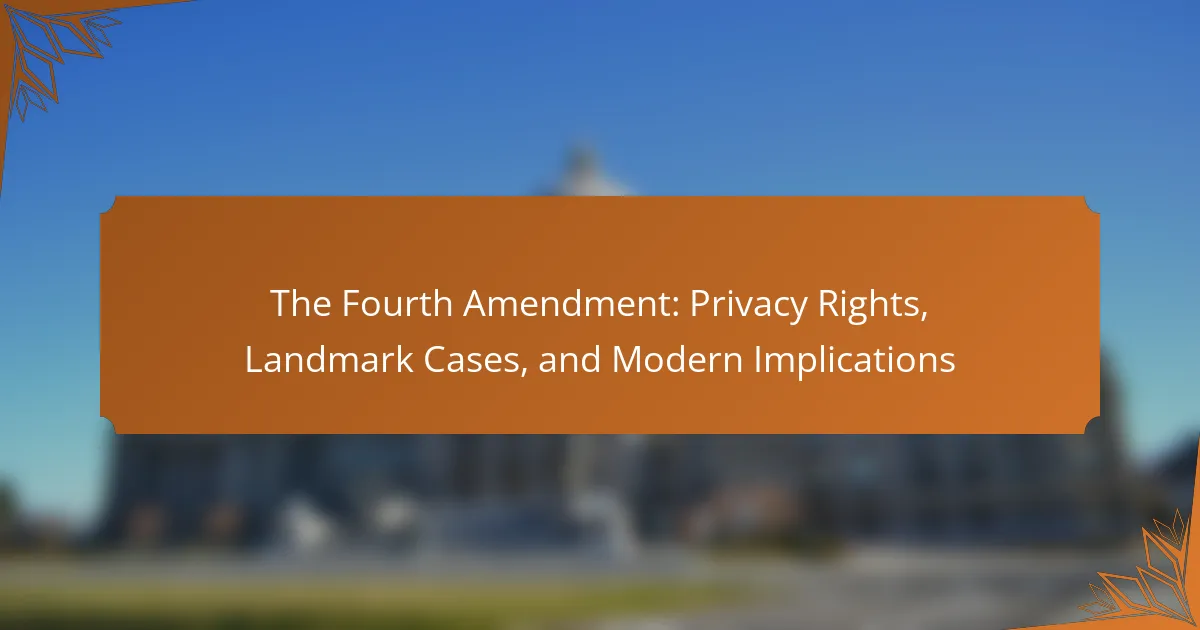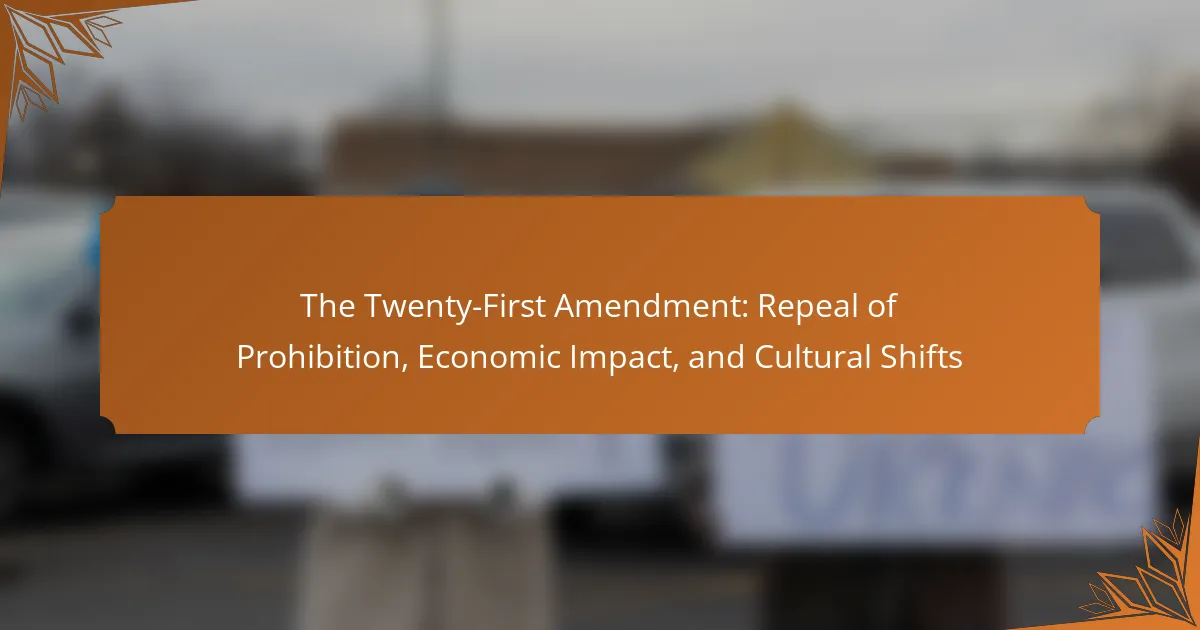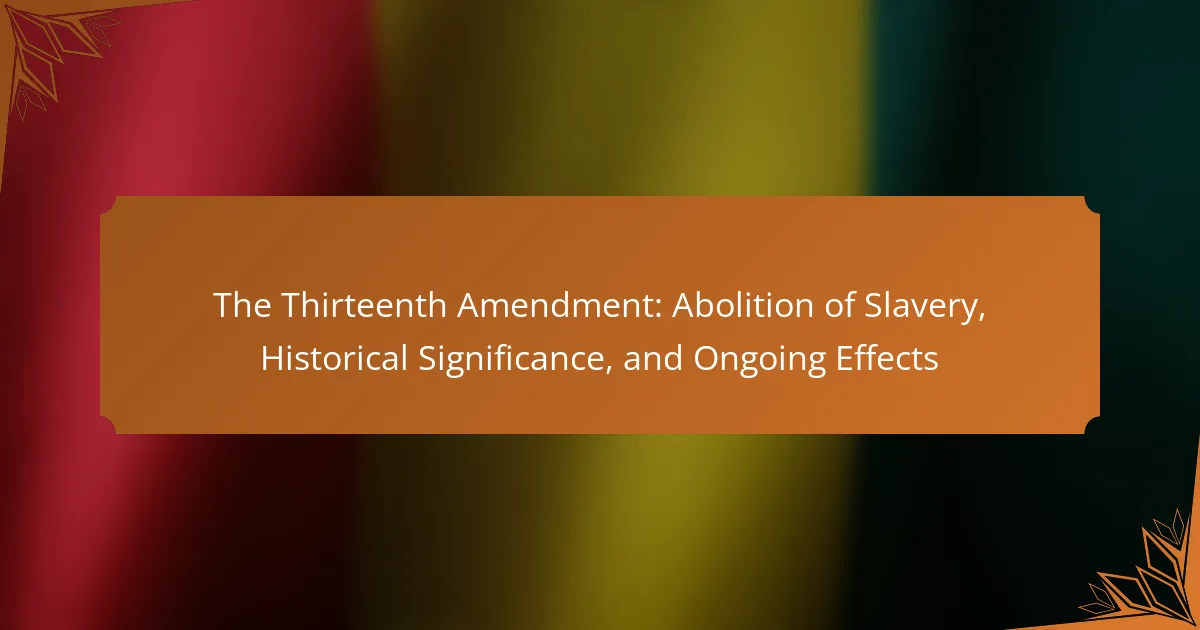The First Amendment of the United States Constitution, ratified on December 15, 1791, is a fundamental legal provision that guarantees essential rights including freedom of speech, religion, press, assembly, and petition. This amendment serves to protect individuals from government interference and is a foundational element of American democracy. Historical context reveals that it was influenced by the Founding Fathers’ experiences with British oppression and Enlightenment ideals. Landmark Supreme Court cases, such as Tinker v. Des Moines and New York Times Co. v. Sullivan, have shaped the interpretation and application of these rights. Contemporary implications include the challenges posed by social media, hate speech, and public demonstrations, highlighting the ongoing relevance of the First Amendment in today’s society.
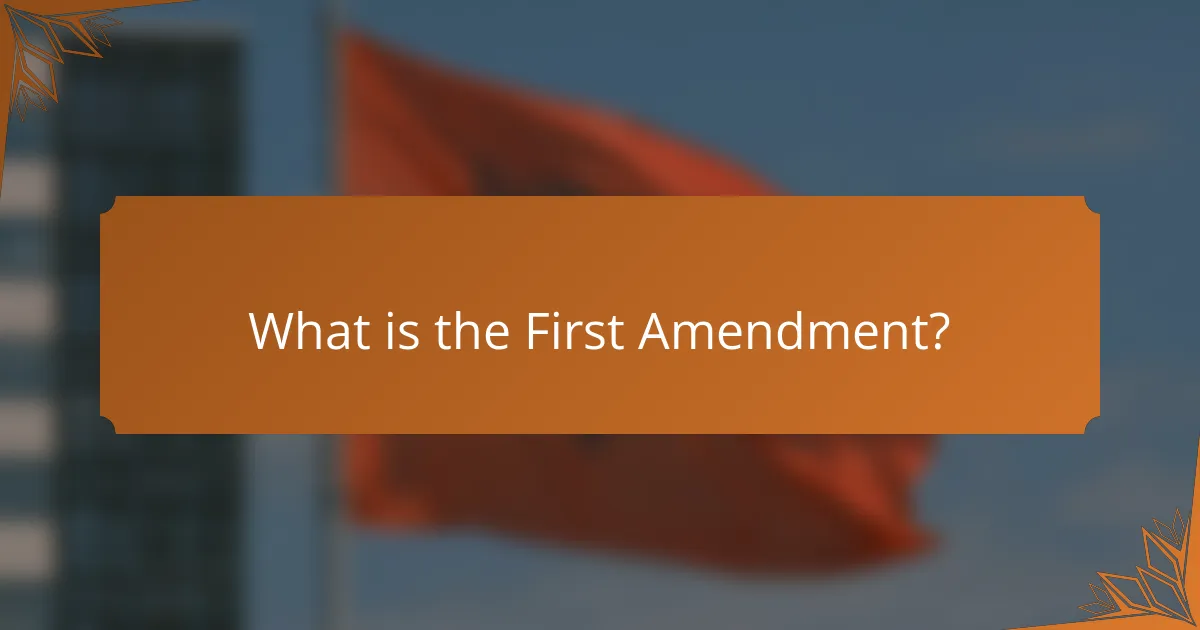
What is the First Amendment?
The First Amendment is a part of the United States Constitution. It was ratified on December 15, 1791. This amendment guarantees several fundamental rights. These rights include freedom of speech, religion, press, assembly, and petition. The First Amendment protects individuals from government interference. It is a cornerstone of American democratic principles. The amendment has been interpreted through numerous Supreme Court cases. Landmark cases include Tinker v. Des Moines and New York Times Co. v. Sullivan. These cases have shaped the understanding of First Amendment rights.
What are the key components of the First Amendment?
The key components of the First Amendment are freedom of speech, freedom of religion, freedom of the press, the right to assemble, and the right to petition the government. Freedom of speech protects individuals from government censorship. Freedom of religion ensures that people can practice their faith without interference. Freedom of the press allows for the dissemination of information and opinions. The right to assemble enables people to gather peacefully for demonstrations or protests. The right to petition allows individuals to make complaints to or seek assistance from their government. These components collectively safeguard essential democratic principles and individual liberties in the United States.
How does the First Amendment protect freedom of speech?
The First Amendment protects freedom of speech by prohibiting Congress from making laws that infringe upon this right. It establishes that individuals can express themselves without government interference. The amendment is part of the Bill of Rights, ratified in 1791. It covers spoken, written, and symbolic speech. Landmark cases like Tinker v. Des Moines (1969) affirm this protection in schools. Additionally, the Supreme Court has ruled against laws that limit speech based on content. This ensures a marketplace of ideas where diverse opinions can coexist. Overall, the First Amendment is essential for a democratic society.
What role does the First Amendment play in religious freedom?
The First Amendment protects religious freedom in the United States. It prohibits Congress from making laws that establish a religion or restrict the free exercise of religion. This ensures individuals can practice their faith without government interference. The Establishment Clause prevents the government from favoring one religion over another. The Free Exercise Clause guarantees the right to worship freely. Historical context shows that these protections were crucial for early American settlers seeking religious refuge. Landmark Supreme Court cases have reinforced these principles, shaping the landscape of religious liberty.
How does the First Amendment safeguard the right to assemble?
The First Amendment safeguards the right to assemble by explicitly protecting the freedom of assembly. This right allows individuals to gather for peaceful protests, demonstrations, and other collective activities. The First Amendment states, “Congress shall make no law… abridging… the right of the people peaceably to assemble.” This legal language establishes a clear prohibition against government interference in peaceful gatherings. Historical context shows that this protection was crucial during the civil rights movement, where assembly played a vital role in advocating for social change. Supreme Court rulings, such as in “NAACP v. Alabama,” have reinforced this right by affirming that the government cannot impose unreasonable restrictions on peaceful assembly. Thus, the First Amendment serves as a foundational legal safeguard for collective expression and civic engagement.
Why is the First Amendment considered fundamental to democracy?
The First Amendment is considered fundamental to democracy because it protects essential freedoms. These freedoms include speech, religion, press, assembly, and petition. They enable open dialogue and diverse viewpoints. This is crucial for informed citizen participation. Historical context shows that these rights were established to prevent government oppression. The First Amendment promotes accountability by allowing criticism of government actions. It encourages public discourse, which is vital for democratic governance. The protection of these rights fosters a society where ideas can be freely exchanged. This foundation is essential for the functioning of a healthy democracy.
What impact does the First Amendment have on public discourse?
The First Amendment significantly impacts public discourse by protecting free speech and expression. It allows individuals to voice their opinions without government interference. This protection fosters a diverse exchange of ideas. It encourages open debate on social and political issues. The amendment also safeguards the press, enabling investigative journalism. This role is vital for informing the public and holding power accountable. Historical cases, such as Tinker v. Des Moines, illustrate its importance in schools. Overall, the First Amendment is foundational for a healthy democratic society.
How does the First Amendment influence government accountability?
The First Amendment influences government accountability by protecting freedom of speech, press, and assembly. These rights enable citizens to criticize government actions without fear of retaliation. This openness encourages transparency and demands that government officials act in the public’s interest. Historical examples include the press exposing government misconduct, such as the Watergate scandal. The ability to gather and disseminate information is vital for informed public discourse. When citizens can freely express dissent, they hold government accountable for its policies and actions. Thus, the First Amendment serves as a crucial mechanism for promoting democratic governance and accountability.
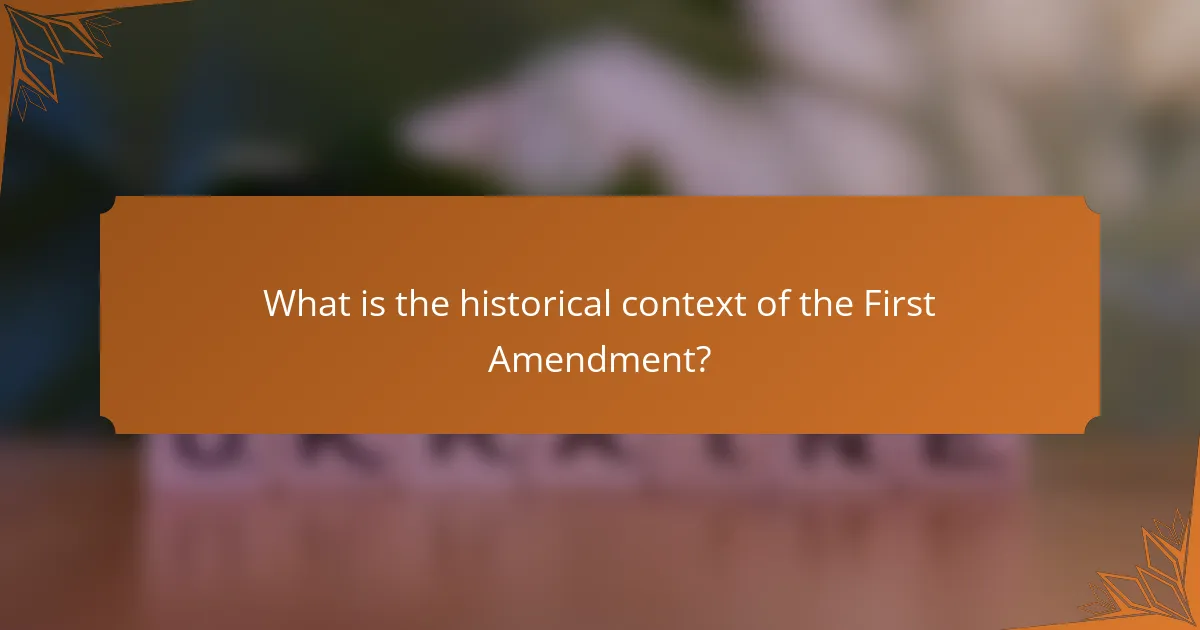
What is the historical context of the First Amendment?
The First Amendment was adopted on December 15, 1791, as part of the Bill of Rights. It aimed to protect individual liberties and limit government power. The historical context includes the Founding Fathers’ experiences with British censorship and oppression. They sought to ensure freedom of speech, religion, press, assembly, and petition. These rights were influenced by Enlightenment ideals and earlier documents like the Virginia Declaration of Rights. The amendment reflects a commitment to democratic principles and civil liberties. Its adoption marked a significant step in establishing a framework for American democracy.
How did the First Amendment come to be ratified?
The First Amendment was ratified on December 15, 1791. It was part of the Bill of Rights, which consists of the first ten amendments to the United States Constitution. The amendment was proposed by Congress in 1789. It aimed to protect individual liberties, including freedom of speech, religion, press, assembly, and petition. The ratification process required approval from three-fourths of the states. By December 15, 1791, the required number of states had ratified the amendment. This marked a significant commitment to safeguarding personal freedoms in the new nation. The First Amendment has since become a cornerstone of American democracy.
What were the key debates surrounding the First Amendment’s creation?
The key debates surrounding the First Amendment’s creation focused on the balance between individual freedoms and governmental authority. One major discussion was the extent of free speech protections. Some framers believed unrestricted speech could threaten social order. Others argued that free expression was essential for democracy. Additionally, the inclusion of freedom of religion sparked contention. Debates arose over whether to protect all religious practices or favor certain beliefs. The role of the press also generated discussion. Some framers wanted to ensure a free press to hold the government accountable. Others feared that a free press could spread misinformation. Ultimately, these debates shaped the First Amendment’s language and intent, reflecting a compromise between competing values.
Who were the major figures involved in the First Amendment’s development?
The major figures involved in the First Amendment’s development include James Madison, Thomas Jefferson, and George Mason. James Madison is often called the “Father of the Constitution.” He played a crucial role in drafting the Bill of Rights, which includes the First Amendment. Thomas Jefferson, although not directly involved in its drafting, strongly advocated for the protection of individual liberties. His correspondence with Madison influenced the amendment’s formulation. George Mason, a delegate at the Constitutional Convention, proposed the idea of a bill of rights. His work laid the groundwork for the First Amendment’s protections. These figures collectively shaped the foundational principles of free speech, religion, press, assembly, and petition in American democracy.
What historical events have shaped the interpretation of the First Amendment?
Key historical events that have shaped the interpretation of the First Amendment include the Alien and Sedition Acts of 1798. These acts restricted free speech and press, prompting debates on government authority. The Supreme Court case Schenck v. United States in 1919 established the “clear and present danger” test for free speech limitations. The Civil Rights Movement in the 1960s further influenced interpretations, emphasizing the importance of protest and assembly. Landmark cases like Tinker v. Des Moines Independent Community School District in 1969 protected student speech rights. The Pentagon Papers case in 1971 reinforced press freedom against government censorship. Each of these events contributed significantly to evolving understandings of First Amendment rights.
How have landmark Supreme Court cases influenced First Amendment rights?
Landmark Supreme Court cases have significantly shaped First Amendment rights. Cases such as Schenck v. United States established the “clear and present danger” test. This test limited free speech during wartime. In Tinker v. Des Moines Independent Community School District, the Court affirmed students’ rights to free expression in schools. This case protected symbolic speech, such as wearing armbands. In New York Times Co. v. Sullivan, the Court set a high standard for defamation cases involving public figures. This ruling reinforced press freedom and protected journalistic expression. Additionally, Citizens United v. Federal Election Commission expanded political speech rights for corporations. These cases collectively illustrate how judicial interpretations have evolved First Amendment protections over time.
What role did social movements play in expanding First Amendment protections?
Social movements significantly contributed to the expansion of First Amendment protections. They mobilized public opinion to advocate for free speech and assembly rights. Historical examples include the Civil Rights Movement and anti-war protests. These movements highlighted the need for broader interpretations of free expression. Landmark cases, such as Tinker v. Des Moines (1969), reflected these societal changes. In Tinker, the Supreme Court affirmed students’ rights to free speech in schools. This ruling underscored the influence of grassroots activism on legal standards. Social movements have consistently pushed for inclusivity in First Amendment protections. Their efforts have shaped the evolving landscape of American civil liberties.
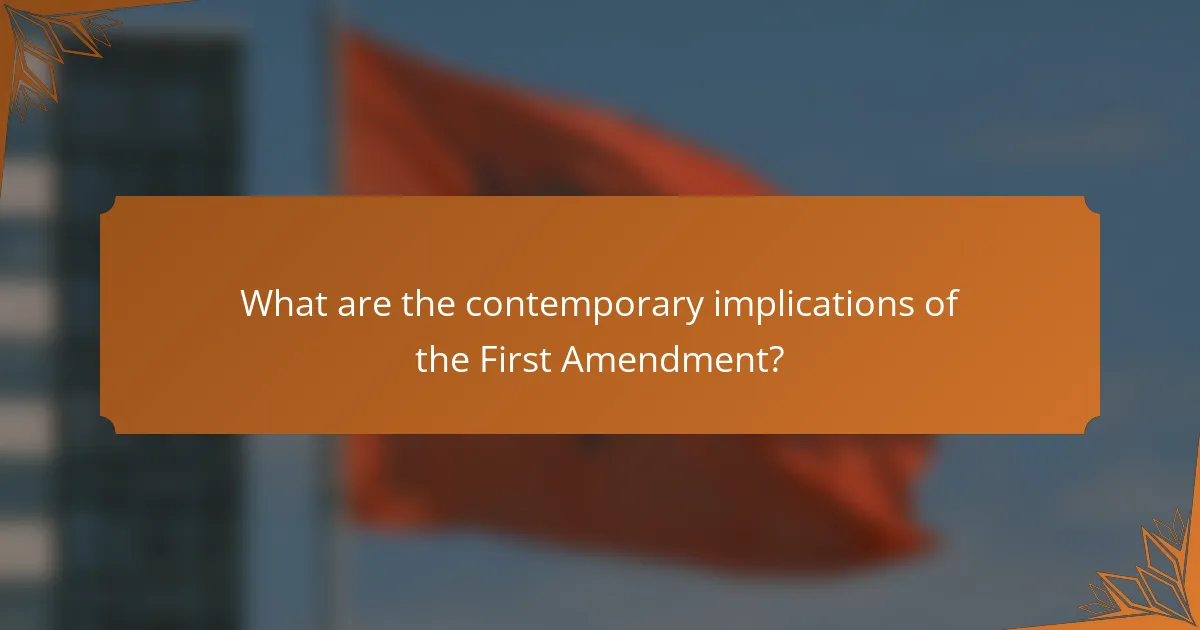
What are the contemporary implications of the First Amendment?
The contemporary implications of the First Amendment include the protection of free speech, press, and assembly. These rights are essential for democratic participation and discourse. In recent years, social media has become a significant platform for expression. This raises questions about regulation and censorship. Courts have addressed cases involving hate speech and misinformation. The First Amendment also impacts protests and public demonstrations. Legal precedents shape how these rights are applied today. Overall, the First Amendment continues to influence societal norms and legal standards.
How is the First Amendment applied in today’s society?
The First Amendment is applied in today’s society by protecting freedoms of speech, religion, press, assembly, and petition. These rights enable individuals to express opinions and beliefs without government interference. For example, social media platforms serve as modern venues for free expression. Court cases, such as Tinker v. Des Moines Independent Community School District, affirm students’ rights to free speech in schools. Additionally, protests and demonstrations are protected forms of assembly under the First Amendment. Recent rulings continue to shape the application of these rights, addressing issues like hate speech and online expression. Overall, the First Amendment remains a cornerstone of American democracy, influencing societal norms and legal standards.
What challenges does the First Amendment face in the digital age?
The First Amendment faces several challenges in the digital age. One major challenge is the spread of misinformation online. Social media platforms can amplify false information rapidly. This raises concerns about the balance between free speech and public safety. Another challenge is the regulation of hate speech. Defining hate speech in a digital context can be complex. Additionally, the role of tech companies as gatekeepers complicates First Amendment protections. These companies can censor content based on their policies. This raises questions about who controls public discourse online. Privacy concerns also intersect with First Amendment rights. Surveillance and data collection can chill free expression. Overall, these factors create a dynamic landscape for First Amendment rights in the digital realm.
How do current events affect public perception of First Amendment rights?
Current events significantly influence public perception of First Amendment rights. High-profile incidents, such as protests or government actions, often spark debates about free speech. For example, during the Black Lives Matter protests in 2020, many Americans expressed heightened awareness of their rights to assemble and speak freely. Media coverage of these events shapes public understanding and attitudes toward First Amendment protections. Research shows that increased visibility of free speech issues can lead to greater public support for these rights. Additionally, political discourse surrounding current events can polarize opinions on what constitutes protected speech. Overall, current events serve as catalysts for public engagement with First Amendment rights.
What are best practices for exercising First Amendment rights?
Best practices for exercising First Amendment rights include understanding your rights, staying informed about local laws, and engaging in peaceful expression. Knowing that the First Amendment protects freedom of speech, religion, press, assembly, and petition is essential. Individuals should be aware of the limitations, such as speech that incites violence or poses a threat.
Public forums, such as parks and streets, are ideal for peaceful demonstrations. Engaging in respectful dialogue fosters constructive conversations. Documenting interactions with authorities can provide protection if disputes arise. Educating oneself on historical cases, like Tinker v. Des Moines, reinforces the importance of these rights.
Maintaining a clear message and purpose during protests enhances effectiveness. Collaborating with organizations that advocate for civil liberties can provide support and resources. Overall, proactive engagement and awareness are key to effectively exercising First Amendment rights.
How can individuals effectively advocate for their First Amendment rights?
Individuals can effectively advocate for their First Amendment rights by educating themselves about these rights. Understanding the specifics of free speech, religion, press, assembly, and petition is crucial. They can participate in discussions and forums that promote awareness of First Amendment issues. Engaging with local advocacy groups can amplify their voices. Writing to elected officials about concerns related to First Amendment rights can influence policy. Utilizing social media platforms to raise awareness also plays a significant role. Documenting and reporting violations helps create a record for accountability. Legal support from organizations specializing in civil liberties can provide guidance and assistance. These actions collectively strengthen the protection of First Amendment rights in society.
What resources are available for understanding First Amendment protections?
Resources for understanding First Amendment protections include legal textbooks, online databases, and educational websites. The American Civil Liberties Union (ACLU) provides extensive resources on First Amendment rights. The National Constitution Center offers interactive materials and articles. The Library of Congress has historical documents related to the First Amendment. Additionally, academic journals contain scholarly articles analyzing First Amendment cases. Law school libraries also provide access to case law and legal commentary. These resources help clarify the scope and implications of First Amendment protections.
The First Amendment is a critical component of the United States Constitution, ratified on December 15, 1791, which guarantees fundamental rights including freedom of speech, religion, press, assembly, and petition. This article provides an overview of the key components of the First Amendment, its historical context, and landmark Supreme Court cases that have shaped its interpretation and application. It also examines contemporary implications, challenges in the digital age, and best practices for exercising these rights, highlighting the ongoing importance of the First Amendment in American democracy.
